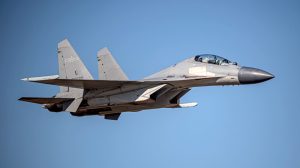China’s military sent 103 warplanes toward Taiwan in a 24-hour period in what the island’s Defense Ministry called a recent new high.
The planes were detected between 6 a.m. on Sunday and 6 a.m. on Monday, the ministry said. As is customary, they turned back before reaching Taiwan. Chinese warplanes fly toward the self-governing island on a near-daily basis but typically in smaller numbers. The Taiwan ministry didn’t explain what time period it meant by a “recent” high.
China, which claims Taiwan as part of its territory, has conducted increasingly large military drills in the air and waters around Taiwan as tensions have grown between the two and with the United States. The U.S. is Taiwan’s main supplier of arms and opposes any attempt to change Taiwan’s status by force.
The Chinese government would prefer that Taiwan come under its control voluntarily. Last week, China’s government unveiled a plan for an integrated development demonstration zone in Fujian province, trying to entice Taiwanese even as it threatens the island militarily in what experts say is China’s long-running carrot and stick approach.
The recent actions may be an attempt to sway Taiwan’s presidential election in January. The governing Democratic Progressive Party, which leans toward formal independence for the island, is anathema to the Chinese leadership. China favors opposition candidates who advocate working with the mainland and are open to eventual unification.
The presidential candidates had no immediate comment Monday on the latest Chinese military activity.
Taiwan’s Defense Ministry said 40 of the planes crossed the symbolic median line between mainland China and the island. They included more than 30 fighter jets as well as midair refueling tanker planes and airborne early warning and control aircraft. Taiwan also reported nine Chinese naval vessels in area waters in the previous 24 hours.
The ministry called the Chinese military action “harassment” that it warned could escalate in the current tense atmosphere. “We urge the Beijing authorities to bear responsibility and immediately stop such kind of destructive military activities,” it said in a statement.
Chinese Foreign Ministry spokesperson Mao Ning, asked about the reported military activity, said there is no such thing as a “median line” because Taiwan is part of Chinese territory.
The median line had been quietly respected – though never officially committed to – by both China and Taiwan since 1955, when it was demarcated by a U.S. general. That tacit acceptance seems to have shattered amid the uptick in Chinese military activity following then-U.S. House Speaker Nancy Pelosi’s visit to Taiwan in August 2022. As Adrian Ang U-Jin and Olli Pekka Suorsa wrote in a recent analysis for The Diplomat:
Prior to Pelosi’s visit… only two out of the 466 recorded PLA incursions involved the PLA flying sorties across the median line of the Taiwan Strait… In the year since Pelosi’s visit, there have been over 140 incursions across the median line (on average approximately once every 2.5 days), totaling more than 1,000 sorties and an average of seven aircraft per incursion.
The authors also noted that large-scale sorties – consisting of 20 or more aircraft – were “relatively rare,” accounting for just six of 142 median line incursions. The 40 aircraft that crossed the line on Monday thus marked an unusual incident, even in the context of China’s stepped-up military maneuvers in the Taiwan Strait since August 2022.
China last week sent a flotilla of ships including the aircraft carrier Shandong into waters near Taiwan. The drills came shortly after the United States and Canada sailed warships through the Taiwan Strait, the waters that separate the island from the mainland.
Taiwan and China split in 1949 when the Communists took control of China during a civil war. The losing Nationalists fled to Taiwan and set up their own government on the island.
Only 13 foreign nations give Taiwan’s government official diplomatic recognition. The U.S. among others has formal ties with China while maintaining a representative office in Taiwan.

































